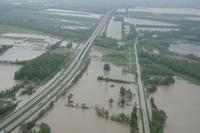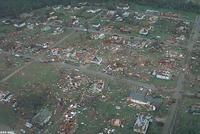-
Missouri Governor pledges $25 million for flood relief
On Tuesday, Missouri Governor Jay Nixon pledged $25 million in state aid to help cities and counties rebuild following crippling floods throughout the southern half of the state; it is unclear whether the state will be forced to make budget cuts in order to afford the disaster spending; on Monday President Obama issued a major disaster declaration for five Missouri counties; under the declaration residents of the five counties are eligible to apply for federal assistance for the costs of temporary housing, home repairs, and loans to cover uninsured losses
-
-
Australian floods and cyclone cost economy $6.6 billion
The devastating floods and cyclone that ravaged Australia last summer has cost the country’s economy more than $6.6 billion dollars; as the country begins to rebuild, the economy must deal with the loss of nearly $9 billion dollars, half a percentage point of real GDP, in production revenues, primarily from the coal and agriculture industry; the government plans to spend nearly $7 billion over the next six years to help communities rebuild, despite an expected loss in tax revenues of $1.75 billion
-
-
Tiltable-head robots adept at navigating disaster debris

Search and rescue missions have made the headlines in the last eighteen months, following the earthquakes in Haiti and Chile, the floods in Pakistan and New Zealand, and the tsunami in Japan; machines able to navigate through complex dirt and rubble environments could have helped rescuers after these natural disasters, but building such machines is challenging; Georgia Tech researchers have now built a robot that can penetrate and “swim” through granular material
-
-
World's largest reinsurer posts lower losses than expected

The world’s largest reinsurer, Munich Re, posted smaller than expected losses for the first quarter of this fiscal year; the insurance giant warned investors for a “clearly negative” quarter as a result of insurance claims following the devastating earthquakes in Japan and New Zealand this year; but, its net losses were mitigated in large part by smaller tax bills as a result of the natural disasters; industry analysts expected the reinsurance giant to post a loss of roughly 1.6 billion Euros ($2.28 billion), however the firm defied expectations posting a net loss of 947 million Euros thanks to a favorable tax gain of 612 million Euros due to its quarterly losses
-
-
Difficult decisions for Japanese living near Fukushima
Japanese residents living just outside the twelve mile evacuation zone of the Fukushima Daiichi power plant have struggled with their daily lives as the plant has continued to spew radiation; while Japanese officials have said that the radiation levels outside the evacuation zone are not high enough to cause observable health risks, many residents and scientists are still worried as radiation is still several times above the normal level; experts acknowledge their limited understanding of the health risks for long term exposure to low doses of radiation has made it difficult for scientists and policy makers to come to an agreement on what levels of radiation are safe and what areas need to be evacuated
-
-
Japan attempts "cold shutdown" at reactor no. 1

Officials at the Tokyo Electric Power Company (TEPCO) hope to bring reactor no. 1 at the beleaguered Fukushima Daiichi nuclear plant to a “cold shutdown” by the end of the week; plant operators will attempt to bring the temperature inside the reactor below the boiling point of water so that it will no longer produce radioactive steam; the building housing reactor no. 1 must be vented so that all the radioactive air that has accumulated is released allowing workers to approach the reactor; once inside workers will inject cold water into the reactor’s primary containment structure; injecting tons of water into a damaged containment unit that houses uranium makes some scientists uneasy
-
-
Missouri levee blast floods 130,000 acres, but saves Illinois city

On Tuesday, the U.S. Army Corps of Engineers blasted a section of a levee along the Mississippi River to create a controlled breach that would relieve pressure and prevent the town of Cairo, Illinois from becoming engulfed in record flood levels; the blast created a gap more than 10,000 feet wide at Birds Point, Missouri levees and inundated more than 130,000 acres of farmland; heavy rains have left the Mississippi and Ohio Rivers swollen, putting Cairo and its 3,000 residents at great risk as it sits on a narrow stretch of land between the two surging rivers; on Monday, the Corps received permission from the federal government to go ahead with its plan, despite Missouri’s protests
-
-
Government moves quickly to help storm victims in South

So far residents have been fairly pleased with the government’s response to the worst natural disaster to hit the United States since Hurricane Katrina; after tornadoes touched down in seven states on Wednesday, Secretary Napolitano and other top federal officials immediately began contacting governors in the affected states; just hours after the storms had ravaged Alabama, Obama signed the declaration of disaster in Alabama and by Thursday he had done the same for Georgia and Mississippi; by Friday afternoon FEMA liaison officers had been deployed to Alabama, Georgia, Kentucky, Mississippi, and Tennessee; the storms have killed at least 350 people, injured more than 2,200, and left tens of thousands homeless in seven states
-
-
California school building regulators had ties with anti-regulation lobby group
A California watchdog group recently revealed that state officials in charge of enforcing earthquake standards for school buildings have had a long and questionable relationship with a lobbying group that actively works to oppose building safety regulations in public schools; senior officials with the Division of the State Architect had been dues paying members of the Coalition for Adequate School Housing, which actively lobbies for less regulation on school construction; in 1997, state regulators were told that taxpayers would reimburse their membership dues to be a part of the lobbying group; officials maintain that there has been no corruption; in 2010 a major regulatory provision in place since 1933 was removed
-
-
DHS IG criticizes FEMA's IT systems
DHS Inspector General says that FEMA’s IT systems “do not support disaster response activities effectively”; the IG recommends that FEMA develop a comprehensive IT strategic plan with clearly defines goals and objectives to support program IT initiatives, and that FEMA establish an agency-wide IT budget planning process to include all FEMA program technology initiatives and requirements
-
-
Busy hurricane season ahead for U.S.
Forecasting organizations predicts that the coming hurricane season in the United States will see 15 named storms, 8 hurricanes, and 4 intense hurricanes (category 3 or greater); these 2011 forecast numbers are above the long-term (1950-2010) averages of 12 named storms, 7 hurricanes, and 3 intense hurricanes
-
-
Missouri pounded by rains and tornadoes, thousands evacuate
This week heavy rain storms are raging across the mid-west and south forcing thousands of residents in Missouri to flee as swollen rivers threaten to flood their homes; in some areas emergency responders do not have many options and can do nothing but hope that the levees hold; the mid-west will not see any respite from the storms until Thursday as another major storm system is about to hit; officials are bracing for substantial flooding; the region is still struggling to recover from major storms that spawned tornadoes in six states killing forty-five people and damaging structures; Missouri has requested aid from the Federal Emergency Management Agency
-
-
Japanese app helps spread earthquake warning
After the 9.0 magnitude earthquake and tsunami ravaged Japan, hundreds of thousands of people have signed up for a new emergency warning app for their iPhones; when an earthquake is predicted to hit, the iPhone app, called Yure Kuru, will send out an alert and let subscribers know when the quake is coming, where the epicenter is located, and how bad the shaking will be; the app was developed by Tokyo based RC Solution Co., which specializes in mass alert systems and spreading information in the event of an emergency; since the 11 March earthquake, the company’s subscribers have sky rocketed from 100,000 to more than 1.5 million
-
-
Japan quake reconstruction could take ten years
Yesterday an advisory panel to the Japanese government announced that it could take a decade to rebuild Japan after the 11 March earthquake and tsunami wiped out much of north-eastern Japan; the council said that the first three years alone would be devoted to building roads and erecting temporary housing for the thousands of families that have been displaced; rebuilding towns could take another four years and a full recovery might take even longer; the damage from the recent quake was far greater than the large quake that struck Japan in 1995; Prime Minister Kan’s cabinet has approved almost $50 billion in spending for post-earthquake rebuilding
-
-
Iran's control systems attacked by another virus

Iran admitted it has been attacked by another virus aiming to disrupt its industrial control systems; the commander of Iran civil defense said, though, that the virus has been caught in time and neutralized by Iran’s “young experts”; Gholamreza Jalali described the virus as “congruous and harmonious with the (computer) system and in the initial phase it does minor damage and might be mistaken for some executive files of government organizations”; in the summer, nearly 42,000 computers and servers in Iran’s industrial control systems — many of them in Iran’s nuclear weapons program — were infected; the damage to uranium enrichment centrifuges was especially great, causing Iran in mid-November to halt enrichment operations; Stuxnet has also infected the Bushehr nuclear reactor; the reactor was supposed to come on line in August, but it is still not operational, and has missed several start-up deadlines
-
More headlines
The long view
The Surprising Reasons Floods and Other Disasters Are Deadlier at Night
It’s not just that it’s dark and people are asleep. Urban sprawl, confirmation bias, and other factors can play a role.
Why Flash Flood Warnings Will Continue to Go Unheeded
Experts say local education and community support are key to conveying risk.
